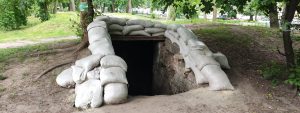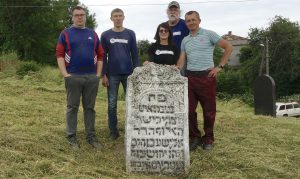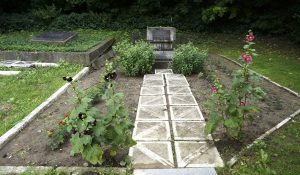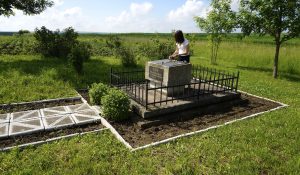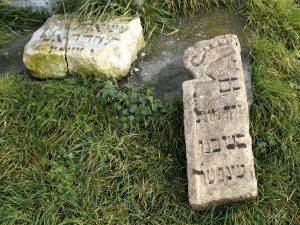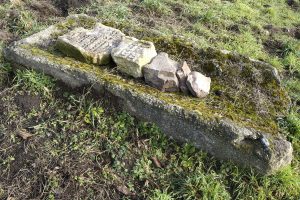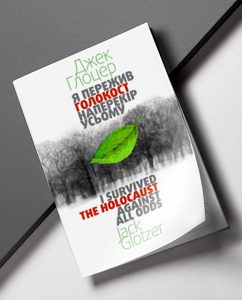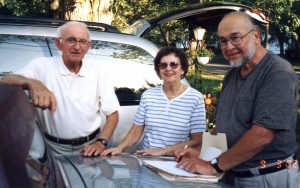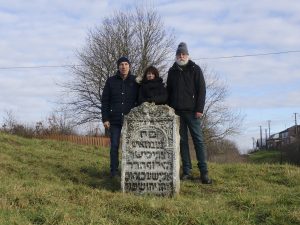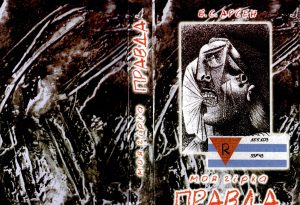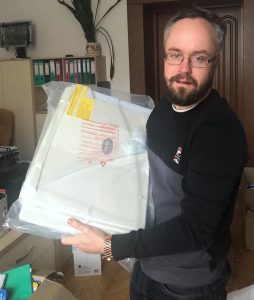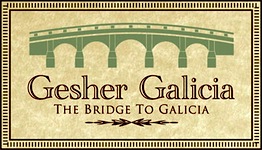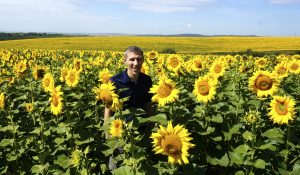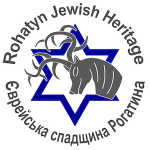 This is a descriptive annual report for Rohatyn Jewish Heritage (RJH) covering the calendar year 2022. It’s our sixth consecutive report, reflecting the number of years we have operated as a volunteer-led non-profit NGO in Ukraine. As for every year, this report summarizes our project progress and events, with an outline of our NGO finances as well. This year brought tremendous upheaval to our organization and everyone in Ukraine; see our report for 2021, when Covid was the primary threat, for comparison (prior years’ reports are also accessible in the news section of this website). Many sections of this review are hyperlinked to pages with more information, on or off of our website.
This is a descriptive annual report for Rohatyn Jewish Heritage (RJH) covering the calendar year 2022. It’s our sixth consecutive report, reflecting the number of years we have operated as a volunteer-led non-profit NGO in Ukraine. As for every year, this report summarizes our project progress and events, with an outline of our NGO finances as well. This year brought tremendous upheaval to our organization and everyone in Ukraine; see our report for 2021, when Covid was the primary threat, for comparison (prior years’ reports are also accessible in the news section of this website). Many sections of this review are hyperlinked to pages with more information, on or off of our website.
![]() Ця стаття також доступна українською.
Ця стаття також доступна українською.
WAR
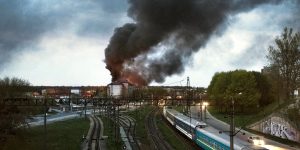
A Russian missile strike at a power plant in our home city of Lviv late this year. Source: New York Times.
Almost everything we did this year, from heritage projects to history and memory work, was impacted by the ongoing criminal war Russia has inflicted on Ukraine. The war dominated most news sources this year, so we don’t need to summarize it here. Throughout the sections below you will read how we and others adapted to the loss of resources and constant threats in order to continue at least some of our work. Western Ukraine has so far been spared the worst of the direct attacks, though it has taken in millions of internal refugees from regions in the east and south who have lost homes and much more.
As this year closes, frequent (sometimes daily) disruptions to electrical power, communication, and transport continue in the west, and much worse problems seriously plague the rest of the country. The timeline and the eventual outcome of the war remain uncertain, but we join our Ukrainian friends and colleagues in their resolve to liberate and rebuild their cities, towns, and villages, and to restore independent democratic Ukraine. There can be no higher priority here.
CLEARING AND CARE OF THE JEWISH CEMETERIES AND MASS GRAVE SITES
As during Covid, nature ignores the concerns of humans and vegetation continued to flourish during the growing seasons this year. The war delayed Marla’s and my return to Ukraine until the beginning of June, and our first working day in the cemeteries was a week later. We were helped by our long-time supporter Vasyl Yuzyshyn on that day and twice more in June and July, plus by old and new friends Sasha Nazar of the Lviv Volunteer Center and Andrii Muzyka, director of the Museum of the History of Lviv (who has roots in the Rohatyn area). Together we cleared the new cemetery and a large portion of the old cemetery.
During our work in the cemeteries, we were approached by two men who live near the cemeteries who offered to do clearing work for us for hire, and we engaged both of them for this work for the remainder of the season. The war has disrupted the local economy, so this extra paid work is welcome in Rohatyn now, and it helps RJH as well because it is difficult for us to arrange transportation in the current circumstances.
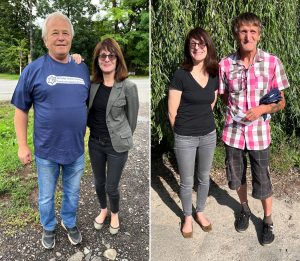
Ihor Zalypko (left) and Vasyl Yurkiv (right), who did the majority of the clearing work at the burial sites this year. Photos © RJH.
We met Vasyl Yurkiv in the new cemetery on our first day working there (he is a neighbor), and he took over clearing work for us for the rest of summer and fall, doing an excellent job during several subsequent clearings. Since 2020, we have contracted with Ihor Zalypko, an engineer at the Rohatyn vodokanal facility (where the north mass graves are located), to care for the memorial monuments at the two mass grave sites, clearing grass around the monuments and planting flowers around them; he continued to do great work on that this year. In addition, he lives just up the road from the old cemetery, so this year we hired him also to clear grass and weeds from that site, a hard, multi-day task he did twice for us. We also hired him to bring a tractor to the old cemetery to remove unsightly construction waste from the front of the cemetery, outside the retaining wall, a task we’ve wanted done for the past few years.
We are very grateful for the work these two men did for us this year; at the end of the season all four sites looked good and stable, and most importantly, remembered. We look forward to continuing this arrangement next year as well, if conditions allow.
REMEMBERING LOCAL HOLOCAUST VICTIMS
The war created intense stress on people and resources in the west from the first day of the new invasion. Less than four weeks after the full invasion, we were forced to cancel a planned commemorative event in Rohatyn to mark the 80th anniversary of the first major aktion during the WWII German occupation, during which most of Rohatyn’s Jewish families were murdered in town and at the south killing site. Each of us remembered the dead wherever we were that day, noting with pain the echoes of Nazi Germany’s destructive actions in the terror brought by Putin’s Russia, already evident from news reports even that early in this year’s war.
Marla and I were able to stand with our friend Vasyl Yuzyshyn in Rohatyn at the north mass grave site on the 79th anniversary of the ghetto liquidation in June, for a somber commemoration despite the ongoing difficulties a few days after our return. We intend to continue these memorial events next year if we can.
Our wish to enhance physical protection of the mass graves, especially at the south site, is on indefinite hold; not only do we lack the significant funds needed to undertake the construction work, projects of this type are impossible now. However, thanks to the leaders of the Ukrainian-German Connecting Memory program, we have access to the architectural and construction plans for several related Holocaust mass grave memorials built by them in Ukraine during the past years, which we can analyze to develop strategies and cost models for our own sites next year and beyond. In the meantime, Ihor Zalypko helped us by taking a tractor to the south site to clear debris and level the ground over the grave with soil added by the City of Rohatyn last year, and the grave remains undisturbed now.
Some progress was made on legal registration of the mass grave sites in Rohatyn, thanks to efforts by our NGO attorney and friend Wito Nadaszkiewicz, with specialist legal advice via the Connecting Memory program. This is a fundamental element of protection of the sites; when completed it will guard the sites forever against encroachment or development, and it will enable prosecution of illicit excavators, should that recur in future years. Wito advised us that Ukrainian laws have changed in a beneficial way for our needs, but unfortunately the war has shifted government administration priorities and it is currently very difficult to advance RJH efforts.
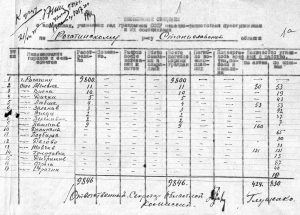
A summary table from the district report listing numbers of victims in Rohatyn and surrounding villages. Source: GARF R-7021-73-13 via Yad Vashem.
The difficulties which impeded most of our physical heritage projects in Rohatyn this year prompted us to re-focus our efforts on research and work with other intangible resources. Thus we resumed a memory project which we had started years ago, to acquire and interpret reports created as part of the Soviet Extraordinary Commission from 1944 to 1946 following the retreat of the German army from Rohatyn and its district. Several Rohatyn-area Jewish survivors contributed testimony, along with a number of Ukrainian witnesses and village leaders where destruction of community buildings, thefts of livestock and grain, and kidnappings of village youth for forced labor in Germany had taken place. Some of the witness accounts are similar to later testimonies in the Rohatyn Yizkor Book, but these Soviet reports are the first known record, coming only two and three years after the terrible events. Transcribed and translated so far on our website with the help of Vasyl Yuzyshyn and Dr. Alex Feller (who leads the Rohatyn District Research Group) are a late-1944 report fragment which names 167 Rohatyn victims and counts their family members but without testimonies, plus an early 1945 report which includes numerous Jewish testimonies for Rohatyn, and names and counts Ukrainian victims in the surrounding villages. Now in progress for publication in 2023 is transcription and translation of a list of over 1000 named Jewish victims with a count of their family members based on testimony from one or more people with very good knowledge of the prewar community; this Ivano-Frankivsk archive record was highlighted for us through research by Connecting Memory and Alex Feller. Together these several records significantly supplement the victims names published in the Yad Vashem database, in the Rohatyn Yizkor Book, and in other sources, bringing names and recognition back to the disappeared.
HEADSTONE RECOVERY
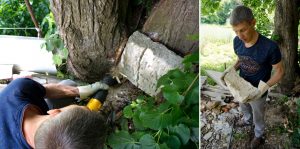
Vasyl works to extract a broken headstone fragment which somehow became lodged in a tree. Photos © RJH.
Even the war did not keep Rohatyn residents from helping us find and recover Jewish headstone fragments scattered around the city, a legacy of the Nazi and Soviet occupations now slowly healing. As in recent years since the passing of our much-missed supporter Mykhailo Vorobets z”l, we were again alerted to new finds via Facebook (both our RJH page and Marla’s personal page), telephone calls, email, and other contacts to Marla or Vasyl. Our first recovery came on our first visit to Rohatyn after our return, when Vasyl cut out a headstone stuck in a tree (!).
We recovered seven headstone fragments this year (the one in the tree was already in two pieces), including both small and medium-sized carved stones, from three locations in Rohatyn near the two Jewish cemeteries. Our Headstone Recovery Project page and map record over 60 separate recoveries and hundreds of headstone fragments returned to the old Jewish cemetery during the the past twelve years. In every year since we first worked in Rohatyn, some or many stones have been recovered with the help of local people. This effort gradually restores an important part of the cultural legacy of the Rohatyn Jewish community.
This year we want to thank our friends Tetiana Petriv and Oleh Hladkyi, who have helped us with headstone recovery in the past, and new friends Olena and Iryna Kurets, for alerting us to the location of discovered headstone fragments. We also want to especially thank Ihor Zalypko and Oleg Sheremet for recovering these stones and returning them to the cemetery, where they are now protected from accidental damage. As always we gratefully thank Vasyl Yuzyshyn for handling much of the communication with Rohatyn residents about discovered headstones, and also for his skill and muscle in extracting the stone from the tree near the Kurets home.
HERITAGE SIGNS FOR THE JEWISH CEMETERIES
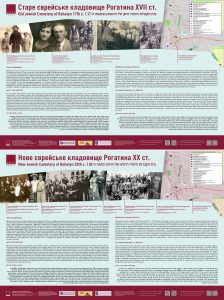
The completed information sign designs for the old cemetery (top) and the new cemetery (bottom). Designs by ESJF from RJH info.
Another project disrupted and delayed by the ongoing war is our effort to place trilingual information signs at the two Jewish cemeteries in Rohatyn, a project we started several years ago but which stalled during the long Covid pandemic and had only just begun again when Russia attacked Ukraine earlier this year. Fortunately, with the significant help from Alexandra Fishel, educational projects officer of ESJF European Jewish Cemeteries Initiative (who has been a refugee abroad from the war), we now have completed designs for both signs, as seen here.
Alexandra was supported in this partnership by ESJF CEO Philip Carmel and office director Alex Bessarab, all of whom we have worked with before on heritage projects and educational materials. On our side we were supported again on translations to Ukrainian by Natalia Kurishko and to Hebrew by Rohatyn descendant Ruthy Erez, and with site planning by our colleague Vasyl Yuzyshyn and by the City of Rohatyn’s architecture department head Stepan Demchyshyn and deputy mayor Mykola Shynkar. The Rohatyn signs, designed by ESJF’s graphics specialist to harmonize with similar signs placed by ESJF at many other cemeteries but using our text, images, and map, will visually link Rohatyn with Jewish community sites elsewhere, including many in western Ukraine. We are grateful that many Rohatyn Jewish descendants shared their family photos with us so that the signs truly represent our unique community, with the faces of Jewish women, men, and children in their everyday lives.
The new signs, which will be 1.5 meters wide by 1.0 meter high, mounted on a steel frame at eye level, will be installed just outside each cemetery. The signs have been ordered and paid for; now we need to wait for a backlog at the fabricator (caused again by the war) to clear and for ground conditions to be suitable for the installation. We hope to be present for the installation in spring of 2023.
A JEWISH MEMOIR OF THE HOLOCAUST READY FOR PRINT PUBLICATION
With generous funding from the Connecting Memory program, support from our Connecting Memory mentor Olha Honchar (director of the Territory of Terror museum in Lviv, as well as the Museum Crisis Center during the war), and significant effort by the Ukrainian Center for Holocaust Studies (UCHS) in Kyiv, a new bilingual edition of Jack Glotzer’s wartime Rohatyn memoir has been completed and will be printed for free distribution to Rohatyn-area libraries and schools in early 2023.
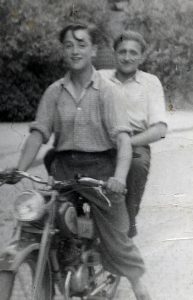
Jack behind his friend Izie Haber in Rohatyn in the late 1930s. Source: Glotzer–Barban Family Collection.
The new book includes parallel texts in Ukrainian and the original English along with a selection of 30 historic and modern photos of Jack’s family, friends, and locations relevant to his story. Vitalii Bobrov, who develops and coordinates educational projects for the UCHS, managed the overall project as well as new scholarly editing and historical annotation of the Ukrainian text, working from Nataliya Kurishko’s translation funded by leaders of the Bolechow Jewish Heritage Society. RJH conducted new research to further annotate the English text from UCHS questions, and revised the text from our 2018 digital edition with skilled editing assistance from Rachel McRae of The Matzevah Foundation (TMF); Rachel and TMF joined us in Rohatyn in 2018 for five days of heavy clearing work at the old Jewish cemetery, which helped to train us in efficient large-scale volunteer projects. As the book development proceeded over four months, we were aided in reviews and with Jack’s family history (and with funding for incidental costs) by Jack’s children Mitchell Glotzer and Terry Glotzer Arons, and in location research by Vasyl Yuzyshyn (as always).
Complementing the book is a new foreword by Dr. Anatolii Podolskyi, director of the UCHS, which provides important socio-historical context especially for young Ukrainian readers of the memoir. Our English translation of Dr. Podolski’s foreword was edited for us by our friend Anna Zolotniuk, a journalist who has traveled with us often to survey and photograph Jewish burial sites in western Ukraine.
When it is released, the book will join others in the UCHS Library of Holocaust Memoirs, a series of books developed in Ukrainian language by the Center over the past decade as references and educational materials, bringing individual voices about the Shoah to a wide audience. Jack’s memoir is of course also featured prominently in our own web series of personal stories and compilations on Jewish life in Rohatyn.
LOOKING FORWARD: CONTINUING AND NEW PROJECTS
Nobody can make long-term plans at this time, but we can hope – first of all for an end to this terrible war, with victory for Ukraine and recovery of its border integrity. Beyond that, we will consider ourselves lucky if we can continue or start some of the following projects in 2023:
- ongoing headstone recovery, where and when fragments are found
- ongoing vegetation clearing at the cemeteries and mass grave sites
- 81-year commemoration at the south mass grave (20 March 2023)
- 80-year commemoration at the north mass grave (6 June 2023)
- print publication of the bilingual Jack Glotzer memoir through the UCHS
- installation of information signs at the old Jewish cemetery and the new Jewish cemetery
- continuing steps toward identification and registration of the mass grave sites in the national register of immovable heritage of Ukraine
We have a number of other projects which are now dormant, waiting for better and more efficient work conditions. Among those are two we started this year with Vasyl Yuzyshyn: an English translation of Borys Arsen’s 2005 memoir My Bitter Truth (Моя гірка правда), a copy of which was gifted to us by the Rohatyn public library, and which includes information about the Holocaust in Rohatyn that we had not read anywhere else; this material will be complemented by transcriptions of USC Shoah Foundation video testimony provided to us by the Connecting Memory program, once those videos are released. We also hope to resume development of a new database framework for documenting headstone fragments recovered to the Rohatyn Jewish cemeteries. For now, larger physical projects such as a memorial monument for the old cemetery and new landscape and monument designs at the south mass grave seem impossible to consider.
ADMINISTRATION
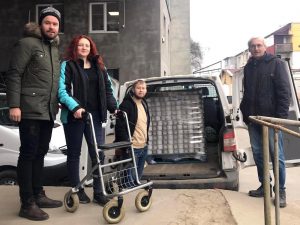
Wito (left) and Bohdan (center) loading yet another van of supplies for people in the east. Photo from Wito’s FB page.
Apart from the burial sites registration effort described above, administrative work for Rohatyn Jewish Heritage this year was relatively light, as our NGO was somewhat hampered by the war and we were unable to undertake larger projects. Of course Wito’s firm LawCraft Legal Services and Consulting in Lviv still needed to maintain our NGO in legal and tax compliance with Ukraine’s laws, as it has since our incorporation in late 2016.
In one bright spot in an otherwise dark year, on behalf of RJH and with the generous support of the Connecting Memory program in Berlin, Wito arranged funding and the purchase of a large-format digital scanner for the Rohatyn Opillya Museum of local history, to help virtually preserve their collections against the risk of physical damage or loss due to the war. Just as we have had to adapt to war conditions in every area of our work, the Connecting Memory coordinators immediately shifted priorities and focus after February 24 to support project teams in different essential ways, while still keeping the long-term program focus on the recovery and preservation of memory.
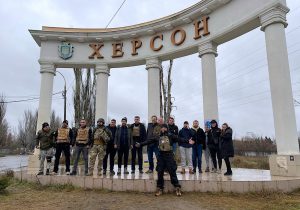
Wito and Bohdan with other volunteers bringing an aid convoy to Kherson shortly after the city was liberated by Ukraine’s army. Photo from Wito’s FB page.
In addition to keeping his law practice running and his staff employed during the war, Wito also used his personal connections to take on a tremendous role in organizing and transporting large shipments of humanitarian aid from Poland to many sites in Ukraine which have been hard hit by the war. Through Polish charities such as Poland Helps and Siepomaga, and with many long trips driven by LawCraft’s attorney Bohdan Zdanevych and Wito’s other colleagues, this work has brought tactical medicines, food, water, warm clothing, stoves, a firetruck, and much more to civilians and military volunteers in Kharkiv, Kyiv, Sloviansk, Kherson, and devastated villages around these and other cities; the mission to Kherson and nearby villages included a 15-vehicle convoy of aid. We are immensely proud of our friends!
As in every year, Wito held RJH NGO legal and administrative expenses very low, waiving many incidental and even larger costs for us, which is a significant charitable gift to our small organization.
FINANCE
Independent of the war or where Marla and I live, since the founding of the NGO we have maintained dual-track personal (US) and NGO (UA) bank accounts to stay flexible and reliable in receiving donations and covering project expenses. We aim for transparency by publishing our NGO income and expenses here, as in past years. We also record and acknowledge all donations (20 individual donations in 2022, though half the net income compared to 2021), and every donation goes directly to project expenses (less banking and transfer fees). This year the special donation from Connecting Memory and the corresponding purchase of the scanner for the Opillya Museum were also counted in the projects section of our finances. Marla and I contribute additional money from our personal savings to cover all administrative, tax, and operational costs, including our own salaries, plus some incidental project expenses (this year we donated two laptop computers). The NGO income and expenses for the calendar year 2022 are listed below in US$ and using a nominal exchange rate of US$1=37UAH to allow for transfer fees and rate fluctuation (after we returned to Lviv the exchange rate jumped from about 29UAH to 37UAH, or 40UAH on the street):
NGO projects & operations: US+UA bank accounts start balance: +$15,459 --------------------------------------- burial sites groundskeeping -$ 2,192 headstone recovery -$ 120 misc. project labor -$ 263 tools, parts & accessories -$ 68 ground transport Lviv/Rohatyn -$ 704 transcription & translation -$ 2,632 signage: design, const, erect -$ 1,470 printing, books, archive fees -$ 349 special – Opillya scanner -$ 670 project legal services -$ (comp) website domain, hosting, apps -$ 408 banking & wire transfer fees -$ 10 --------------------------------------- net change 2022: -$ 8,886 carryover 2021 expenses debt -$ 0 individual donations via GG +$ 5,644 other donations (ConnectMem) +$ 811 --------------------------------------- end project banking balance: +$13,028 2022 unreimbursed expenses -$ 0 --------------------------------------- net end project balance: +$13,028 [balance = +$6,333 US, +$6,695 UA, -$0 debt] [remaining tools and supplies inventory is held by RJH for use in 2023] NGO administration, salaries, etc.: UA bank account start balance: +$ 6,288 --------------------------------------- permit and gov't fees -$ 939 accounting and bank fees -$ 984 salaries+benefits+taxes -$ 5,848 --------------------------------------- net change 2022: -$ 7,771 Osborn personal contribution +$ 7,000 --------------------------------------- end admin balance: +$ 5,517
As always, the figures shown here are current, and may include updates since first reporting to include late-year donations or expenses, and a final reckoning by our NGO accountant.
Once again this year we gratefully thank Gesher Galicia for its volunteer administration contributions, and in particular their PayPal Administrator and Operations Manager Shelley Kellerman Pollero, CFO/Treasurer Darcy Stamler, and President Dr. Steven Turner, for making the donations process to Rohatyn Jewish Heritage tax-deductible for US taxpayers and simple for everyone.
Marla and I continued to volunteer our own time throughout the year to support project work and administration of the NGO, including from abroad until we could return to Ukraine. Despite the difficulties we will continue in 2023 in whatever capacity we can.
THANK YOU TO OUR SUPPORTERS
This year especially, but as in every year, it is clear to Marla and me how much our work depends on our supporters, including those who volunteer with us working in Rohatyn and the region, those who donate to cover the costs of our project work, and those who share ideas and encouragement with us as we continue our efforts.
We would like to highlight one name and face which appears frequently above and in news articles from this year, that of our dear friend and colleague Vasyl Yuzyshyn, who helped us immensely this year again as he has for the past six years, in both tangible and intangible ways. He accompanies us and works with us on all of our days in Rohatyn, and works behind the scenes for us with communication, interpreting, transcriptions and translations, research, software programming, and more. His calm and respectful manner and his gentle humor make him, and us, popular with many people we meet we are proud and lucky to include him in our core team, and to call him our friend.
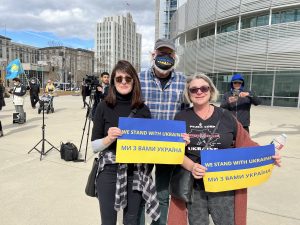
At an anti-war rally in San Jose, California, with a friend who served in the US Peace Corps in Ukraine, on the day we were supposed to fly home to Lviv.
We also named above many of our old and new friends and colleagues who worked with us this year, which was a greater challenge for all of them because of their extra burdens and responsibilities due to the war. It has been an expected but inspiring experience to see how these good people help each other and their country to endure and fight back against this outrageous attack. With gratitude and solidarity Marla and I have been pleased to donate personally to their work as well, when we can, and we encourage everyone abroad to help however possible.
We are grateful that we continue to receive both tangible and intangible support from the City of Rohatyn and from our NGO partners (and friends) ESJF European Jewish Cemeteries Initiative, the Ukrainian Center for Holocaust Studies (UCHS), Connecting Memory, Yahad – In Unum, the Rohatyn District Research Group (RDRG), the Lviv Volunteer Center, and Gesher Galicia.
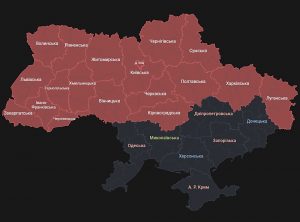
The missile alert map of Ukraine (red is bad) the day after we arrived home in Lviv. The sirens and warnings have sounded more than
120 times in Lviv since then.
We would also like to again acknowledge the many individual donors who provided funding this year to sustain our work in Rohatyn, most of whom have donated in years past as well. Donations fell well short of the costs of our project work this year, understandable in a horrible year when many are giving their money and time to the larger and defense and humanitarian efforts to sustain Ukraine. We are pleased and proud to list this year’s and past donors on our website.
At the end of an extremely dark year, let’s finish on a bright (and amusing) note, and a sign that we are holding on. Once again we managed to spread our “brand” a little wider thanks to friends who are willing to wear our colors with pride (including one photo taken in a bomb shelter in Lviv, and another during a delivery of humanitarian aid from Poland to Ukraine). We say thank you again to everyone who continues to broadcast our messages and efforts to remember, bridge, and work together.

